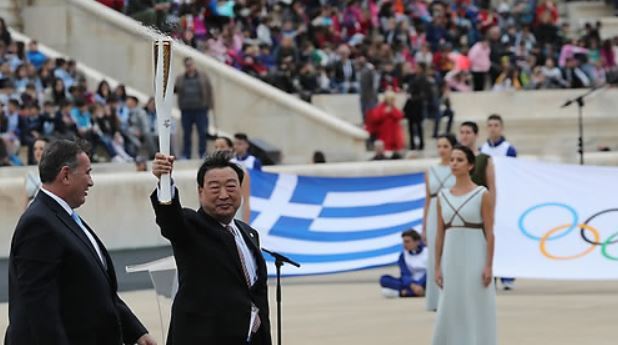INCHEON -- The Olympic flame for the first Winter Games to take place in South Korea arrived in the host country Wednesday, as the countdown to the quadrennial competition reached 100 days.
A 16-member South Korean delegation arrived at Incheon International Airport with the flame after a handover ceremony in Athens, bringing an Olympic torch home for the first time since the Seoul Summer Olympics in 1988.
The flame for PyeongChang was lit at the Temple of Hera in Olympia, Greece, on Oct. 24 and went on an eight-day relay through Greece, the birthplace of the Olympics before making its way to South Korean hands.
The delegation included Lee Hee-beom, head of the PyeongChang Organizing Committee for the 2018 Olympic & Paralympic Games, and Kim Yu-na, 2010 Olympic figure skating champion and an honorary ambassador for PyeongChang 2018.
The flame traveled in a security lamp over the 8,500-kilometer route from Athens to Incheon.
 |
Lee Hee-beom, president of the PyeongChang Organizing Committee for the 2018 Olympic & Paralympic Winter Games (POCOG), holds the Olympic torch at the Panathenaic Stadium in Athens on Oct. 31, 2017. (Yonhap) |
"Today is a very significant moment in history for us," Lee said after landing home with the flame. "The wait is over for South Korea. The Olympic Games and the Olympic flame are symbols of hope and peace. PyeongChang 2018 will be an Olympics of peace and harmony. We will ensure that all athletes and everyone coming to PyeongChang will have the time of their lives."
Kim and Prime Minister Lee Nak-yon then lit the Olympic torch and set the mini cauldron alight on a stage set up on the airport's runway.
The torch relay that will wrap up at the opening ceremony on Feb. 9, 2017, will commence later Wednesday. You Young, who became the youngest national ladies' singles figure skating champion at age 11 in January 2016, will be the first torchbearer in South Korea after the flame's arrival.
The route will cover 2,018 kilometers -- the same number as the year in which the Olympics is taking place -- by plane, ship, train, sailboat, robot, cable car, bike, zip line and foot. The torch will travel through nine provinces, eight major cities, and 151 counties and districts.
The relay will take place under the slogan, "Let Everyone Shine," a nod to the Olympic flame and PyeongChang's hopes of bringing the world together.
PyeongChang said it will select 7,500 runners, along with 2,018 support runners.
"The Olympic torch relay will showcase Korea's unique culture and travel destinations to the world," Lee said. "The relay allows everyone to engage and be a part of the Games."
The torch was designed to keep the flame alive in the high altitudes of PyeongChang, some 180 kilometers east of Seoul in Gangwon Province, and in blustery winter conditions in the region. When wind blows toward the flame, an air tunnel is created to provide more oxygen, which will help keep the flame lit throughout the torch relay. A pentagon-shaped hole in the bottom of the torch will help drain water out in rainy conditions. And a three-layered umbrella-type cover will protect the flame against snow and wind.
The color white drew its cues from white porcelain, and also from snow and ice, two major symbols of the Winter Olympics.
The torch is 700 millimeters tall, representing the altitude of PyeongChang, which sits 700 meters above sea level.
The five-angled shape in the middle of the torch's cap represents "the spirit of sports, which connects races, nations, religions, genders, cultures and the five continents around the world, uniting them with passion," according to PyeongChang organizers.
The torch was designed by South Korean artist Kim Young-se, and was manufactured by Hanwha Corp., which also made the torch for the 1988 Seoul Summer Olympics.
The uniforms for the torchbearers are white, as per International Olympic Committee regulations, with the Olympic Rings and the patterns from the torch emblazoned on them.
The sleeves and the back of the shirt were made with water-repellent materials, while the shoulders and the front are waterproof. A hybrid material has been used for the jacket filling to keep the torchbearers warm in cold conditions.
The shirts were designed by Youngone Outdoor, an official partner of the PyeongChang Winter Games.








